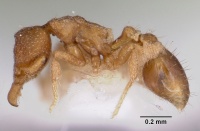Strumigenys acheron
| Strumigenys acheron | |
|---|---|

| |
| Scientific classification | |
| Kingdom: | Animalia |
| Phylum: | Arthropoda |
| Class: | Insecta |
| Order: | Hymenoptera |
| Family: | Formicidae |
| Subfamily: | Myrmicinae |
| Tribe: | Attini |
| Genus: | Strumigenys |
| Species: | S. acheron |
| Binomial name | |
| Strumigenys acheron (Bolton, 2000) | |
Specimens have been collected from rainforest litter in pitfall traps.
Identification
Bolton (2000) - A member of the Strumigenys extemena-group. Within this group acheron, Strumigenys aello and Strumigenys tarbosyne possess erect hairs on the vertex and also on the dorsal alitrunk. On the head pilosity is restricted to a single transverse row behind the highest point in acheron, but in aello and tarbosyne a pair or second row is present more anteriorly, at the highest point of the vertex.
Elsewhere in the group Strumigenys deinognatha, Strumigenys extemena and Strumigenys ocypete altogether lack standing hairs on the vertex, and these three species, together with Strumigenys podarge and Strumigenys atopogenys, do not have any erect hairs on the dorsal alitrunk.
Keys including this Species
Distribution
Latitudinal Distribution Pattern
Latitudinal Range: 5.778° to 5.778°.
| North Temperate |
North Subtropical |
Tropical | South Subtropical |
South Temperate |
- Source: AntMaps
Distribution based on Regional Taxon Lists
Indo-Australian Region: Borneo (type locality), Indonesia, Malaysia.
Distribution based on AntMaps
Distribution based on AntWeb specimens
Check data from AntWeb
Countries Occupied
| Number of countries occupied by this species based on AntWiki Regional Taxon Lists. In general, fewer countries occupied indicates a narrower range, while more countries indicates a more widespread species. |

|
Estimated Abundance
| Relative abundance based on number of AntMaps records per species (this species within the purple bar). Fewer records (to the left) indicates a less abundant/encountered species while more records (to the right) indicates more abundant/encountered species. |

|
Biology
Castes
Nomenclature
The following information is derived from Barry Bolton's Online Catalogue of the Ants of the World.
- acheron. Pyramica acheron Bolton, 2000: 416 (w.) BORNEO. Combination in Strumigenys: Baroni Urbani & De Andrade, 2007: 110
Unless otherwise noted the text for the remainder of this section is reported from the publication that includes the original description.
Description
Worker
Bolton (2000) - Holotype. TL 1.6, HL 0.40, HW 0.37, CI 93, ML 0.12, MI 30, SL 0.18, SI 49, PW 0.23, AL 0.45. Leading edge of scape rounded at broadest point, the edge with a continuous row of small, spatulate to spoon-shaped hairs that are all curved toward the apex of the scape and diminish in size toward the scape apex; without a single enlarged freely projecting hair at the broadest point. Dorsum of head with a thick, blunt transverse ridge running from side to side at about the highest point of the vertex. In full-face view the ridge best developed in the middle third of the head width. In profile the ridge very conspicuous at the highest point of the vertex where it forms a blunt crest, the anterior face of which is almost vertical. Outline of dorsum sloping steeply behind the ridge and with a transverse row of 4 short straight erect hairs in front of the occipital margin; without hairs on the crest of the ridge itself. Erect pilosity otherwise absent from cephalic dorsum. Eye small, partially concealed in holotype but apparently with only 3-4 ommatidia in total. Clypeus with minute and very indistinct appressed pubescence, its median area more or less shining. Dorsum of head behind clypeus finely and densely reticulate-granular to reticulate-punctulate. Dorsolateral margination of pronotum with a short straight hair projecting from just behind the humeri. Mesonotum with a single pair of short straight erect hairs anteriorly; alitrunk otherwise without standing pilosity. Dorsa of petiole, postpetiole and first gastral tergite with numerous short erect simple hairs. Legs with minute appressed pilosity only, directed toward the apices of the segments. Dorsum of pronotum between marginations more or less smooth centrally but with granular sculpture peripherally. Mesonotum markedly narrowed dorsally and finely punctulate; propodeal dorsum smooth. Pleurae and side of propodeum mostly smooth and shining, with weak granular sculpture near the upper margins. Mesonotal convexity very distinctive in profile. Propodeal declivity with broad lamellae. Petiole node in dorsal view much broader than long, weakly punctulate anteriorly but the sculpture fading out posteriorly. Disc of postpetiole smooth and shining.
Type Material
Bolton (2000) - Holotype worker, Malaysia: Sabah, Poring Hot Springs, 500 m., 13.v.1987, no. 23 (Lobl & Burckhardt) (Musee d'Histoire Naturelle Genève).
References
- Baroni Urbani, C. & De Andrade, M.L. 2007. The ant tribe Dacetini: limits and constituent genera, with descriptions of new species. Annali del Museo Civico di Storia Naturale “G. Doria”. 99:1-191.
- Bolton, B. 2000. The ant tribe Dacetini. Memoirs of the American Entomological Institute. 65:1-1028. (page 416, worker described)
References based on Global Ant Biodiversity Informatics
- Pfeiffer M.; Mezger, D.; Hosoishi, S.; Bakhtiar, E. Y.; Kohout, R. J. 2011. The Formicidae of Borneo (Insecta: Hymenoptera): a preliminary species list. Asian Myrmecology 4:9-58
